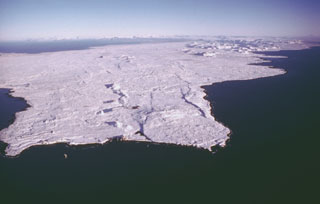Report on Reykjanes (Iceland) — 16 July-22 July 2025
Smithsonian Institution / US Geological Survey
Weekly Volcanic Activity Report, 16 July-22 July 2025
Managing Editor: Sally Sennert.
Please cite this report as:
Global Volcanism Program, 2025. Report on Reykjanes (Iceland) (Sennert, S, ed.). Weekly Volcanic Activity Report, 16 July-22 July 2025. Smithsonian Institution and US Geological Survey.
Reykjanes
Iceland
63.817°N, 22.717°W; summit elev. 140 m
All times are local (unless otherwise noted)
The Icelandic Meteorological Office (IMO) reported that a fissure eruption within the Reykjanes volcanic system began on 16 July in an area NE of Stóra Skógfell, along the Sundhnúkur crater row. According to a news report, the eruption was preceded by a seismic swarm and deformation, prompting authorities to evacuate 20-30 people from the Grindavík campground, about 100 people from the town of Grindavík, and about 200 people from the Blue Lagoon spa. A fissure trending NE-SW opened at around 0356 and propagated N. Lava flows spread laterally from the fissure, mainly to the SE. As the eruption progressed, a second fissure opened. For a short period of time the interaction of groundwater and magma produced tephra-laden gas-and-steam plumes. By noon the entire fissure was about 2.4 km long and consisted of a series of segments that produced lava fountains and flows, with cones forming over vents along the fissure. Lava mainly flowed N and NE, spreading widely across Kálffellsheiði and toward Svartsengi. Lava covered about 3.2 square kilometers, based on satellite images. High concentrations of sulfur dioxide were measured over the Reykjanes Peninsula and were drifting W and SW over the ocean. Smoke from vegetation fires set by the eruption contributed to poor air quality in the region. Later in the evening residents of Grindavík were allowed back into town.
The eruption continued through the night. On 17 July seismic activity was low and eruptive activity was concentrated at about 10 vents. Lava continued to advance E. Foggy weather created poor visibility around the eruption site. Gas dispersal was widespread, with sulfur dioxide concentrations temporarily reaching hazardous levels in some localized areas, including in Akureyri. Due to high levels of volcanic gases authorities advised residents to stay indoors. By 1130 on 18 July activity was concentrated along the central part of the fissure and the seismic network recorded little to no signals. Volcanic smog (vog) had spread over most of Iceland was visible over the ocean to the N and W. By 1130 on 19 July the eruption was concentrated at 2-3 craters and volcanic tremor was low and steady. Two craters were active during 19-20 July and lava flowed E towards Fagradal. Poor air quality from significant amounts of sulfur dioxide emissions near the eruption site and vog continued to affect areas in the W half of Iceland. The northernmost crater ceased to be active at around 2200 on 21 July; one crater was active at least through 1440 on 22 July. Eastward advancement of the lava flows had slowed, and the flows inflated. IMO recommended that the public continue to check weather and gas-dispersion forecasts.
Geological Summary. The Reykjanes volcanic system at the SW tip of the Reykjanes Peninsula, where the Mid-Atlantic Ridge rises above sea level, comprises a broad area of postglacial basaltic crater rows and small shield volcanoes. The submarine Reykjaneshryggur volcanic system is contiguous with and is considered part of the Reykjanes volcanic system, which is the westernmost of a series of four closely-spaced en-echelon fissure systems that extend diagonally across the Reykjanes Peninsula. Most of the subaerial part of the system (also known as the Reykjanes/Svartsengi volcanic system) is covered by Holocene lavas. Subaerial eruptions have occurred in historical time during the 13th century at several locations on the NE-SW-trending fissure system, and numerous submarine eruptions dating back to the 12th century have been observed during historical time, some of which have formed ephemeral islands. Basaltic rocks of probable Holocene age have been recovered during dredging operations, and tephra deposits from earlier Holocene eruptions are preserved on the nearby Reykjanes Peninsula.
Sources: Icelandic Meteorological Office (IMO), Icelandic National Broadcasting Service (RUV)

